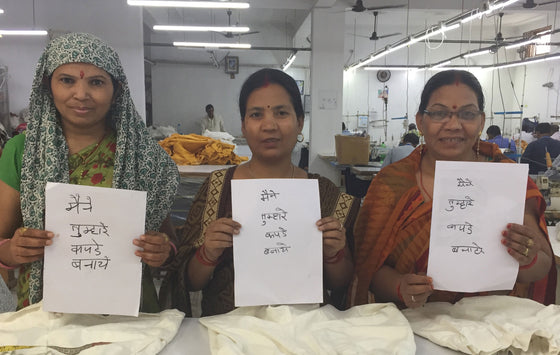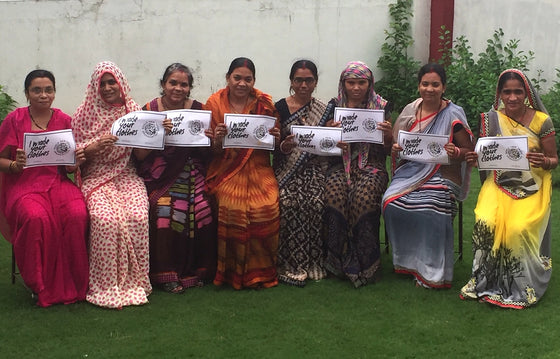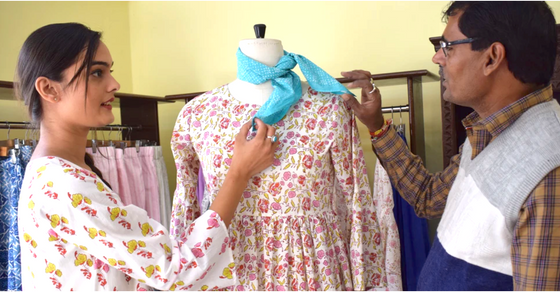Revolution is - Knowing WHO MADE YOUR CLOTHES
April 24, 2016

ANOTHER SIDE TO THE STORY
Ten years ago, while Shari and I were packing up our family for a big move, I came across an old pair of shoes that I had packed away many years before. They had been manufactured back in the 1960’s by a company that I will refer to as RESPECTED SHOES. I didn’t know what to do with them. They were black wingtips. My parents had bought them for me during my senior year in college to go with my new gray flannel suit. My suit was long gone, and these shoes seemed to be hopelessly out of style.
I turned them over in my hands, and examined the amazing tight, perfect stitching, the leather soles and heels with the metal tacks. RESPECTED SHOES were reputed to last from one generation to the next; heels and soles rarely needed restoration.
Another point about RESPECTED SHOES was that they were made in every width, and mine were Double AAs. I have an extremely narrow foot, and I have not been able to find shoes that actually fit me for about the last thirty years. AA and A are long gone. So my feet have been flopping for quite a long time.
RESPECTED SHOES used to be made in the United States. When the move to uproot American industry and offshore manufacturing was getting underway by the early 80’s, RESPECTED SHOES came under the knife of a corporate raider of great renown, who had served as a Cabinet Secretary in the Ford Administration, and had written an influential book about the need to free American business from too much government regulation. He bought out the RESPECTED SHOES factory, sold off its assets, packed up its machinery and sent them overseas. This was in keeping with the general drift of making America “more efficient and competitive.”
One troubling aspect of the story, pointed out by investigative journalists who were pretty much jeered out of hearing range as soon as they piped up, was that RESPECTED SHOES was not only employing hundreds of skilled workers; it was earning a profit.
The business that had been shuttered was not uncompetitive and it was not losing money—just the opposite. But it was an irresistible plum for an outsider aiming for a quick buck, or millions of them. So those workers, through no fault of deficiency of their own, lost their livelihoods, and America lost a great shoe.
The RESPECTED SHOES brand still exists, having been bought up by a larger corporation, but the reports are that the quality is about what we would expect, which is to say, not much.
As a member of the Boomer Generation, who had a view of the deliberate destruction of the American manufacturing sector, small business, and the family farm, I expect that any day some younger person is going to ask me, “How could people your age let this happen? Couldn’t you see it happening?”
And I will have to answer, “Yes, we saw it. But we didn’t know what we were seeing.”
That’s the same answer many of my generation would give about the start of the war in Viet Nam. Or about the early evidence of global warming. Or the corporate takeover our the political system. And on and on.
We saw, but we didn’t know what we were seeing.
By the time we knew what we were seeing, it was too late. Or almost. It’s the almost that many of us are hanging onto now.
At my high school, back in the 60’s we were all subject to a strict dress code—“strict” being the more docile way of putting it. “Ironclad” and “Unyielding” also come to mind.
Show up in school in a T-shirt, and you were sent home immediately. Same for jeans or tennis shoes. Girls had to be in skirts or dresses, absolutely no slacks.
We didn’t mind because we were all into looking sharp or pretty. For the guys, it was right around then that the wing tips became a big thing, along with polished cotton slacks, killer socks, and a very specific brand of shirt.
I was allotted enough clothing allowance for one new pair of pants and two new shirts three times in a school year, if needed. These were very careful purchases, as you might imagine. My goal was to not stand out in the wrong way and my hope was that my collars wouldn’t fray too soon.
Those clothes fit well, looked good, and held up for years, so I didn’t get that many new shirts until I grew out of them.
And they were all made in the U.S., for the most part in the Carolinas.
Of course, that’s all over now.
The last time I drove through South Carolina I was struck by the number of empty shell garment factories. They are still standing, after a generation of idleness, with nothing in them, all the equipment of machinery having been packed up and sold overseas. The small towns they once supported were whittled down to next to nothing. Skilled workers were consigned to unskilled labor, if they were able to find new jobs at all, and now a generation has passed, and those skilled jobs have never come back, never been handed on.
We saw it happening, but we didn’t know what we were seeing.
Sometimes we’re asked “Why don’t you make your clothes in America? Americans need those jobs.”
The short, simple answer is that we didn’t have four or five million dollars to get started. Or ten or twenty million.
What we had was all the money we had ever saved and were currently able to earn. We also had prior, deep ties with India, feeling it was our real home.
And then there is the point about those skilled workers, who have vanished along with the industry they built up. In India, those skills have been passed on, never lost.
So it was India for us. Not the Carolinas, or Chicago, or New York, or St. Louis.
Based on bad earlier experiences in the garment industry, we came up with what we thought was with a brilliant business strategy: we would be honest with our customers, and we would treat our workers fairly and with respect.
We wanted to start the kind of company that we had not been able to find. We wanted to be part of the almost that so many of us are hanging onto, as in “almost too late.”
We saw it happening but we didn’t know what we were seeing.
These days, I often wonder what I may be looking at but not really seeing, not really understanding. If I, like so many others, could have been so blind in the past, could have missed so much, what am I missing now?
And it occurred to me that the thing I might be missing is the re-emergence of what the American writer, Christina Nichol, calls “the law of the human.”
When the general drift seems so bleak, it would be easy enough to miss. So I’m keeping my eyes open, and I’m starting to see more people who are determined to walk a different path.
I know a young man in Minneapolis who started a woodworking business that makes beautiful, high end furniture and office fixtures. He had about thirty men working for him, each a highly skilled individual working on his own projects, and the quality of their work was incredible. They had a clients list of famous names, so I assumed they were making a lot of money. But making a high end product is often means small margins, and he said to me, “I’ve got to keep hustling accounts all the time. I can’t get my own hands on the wood anymore. My greatest fear is that I’m going to have to tell one of these guys that I can’t afford him anymore.”
He had reached the point, in his relationship with his business, where his primary concern was to make enough money to take care of his “guys”. Profit was now subservient to the law of the human.
Mehera Shaw is in the same boat; we are also subservient to this law. We’re not unique in this. Small businesses who are trying to do good, “real” work, like his, like ours, and like others we know, are places where the human factor is taking its rightful and natural place.
I suspect there are more of us than any of us knows.
I’m keeping my eyes open, and this time I hope I know what I’m seeing.
—from the desk of Mark Keller
Leave a comment
Comments will be approved before showing up.








